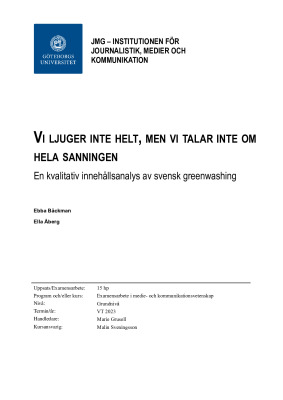VI LJUGER INTE HELT, MEN VI TALAR INTE OM HELA SANNINGEN
En kvalitativ innehållsanalys av svensk greenwashing
Executive summary
In the society of today environmental issues have a major impact on the agenda, which calls for the fact that organisations need to start prioritizing communication that strengthen their environmental profile. Since the demand for environmental friendly products and services
increases the organisations need to work harder to market green products and services. The green marketing also carries a negative part which is the fake and misleading green marketing, greenwashing. Greenwashing is the phenomenon with the use of nature and
environment in advertisements to highlight products or services in a much more environmental friendly way than what they are like in reality.
Therefore it is relevant to study greenwashing from a society perspective since it might undermine consumers trust in green marketing and in organisations in the field. It is also relevant for the society in an ethical and legal perspective hence this marketing can be false both ethically and legally. From an academic perspective this study is also relevant due to the fact that there are studies on greenwashing but none of them from Sweden. We will deal with this lack of knowledge through a content perspective, our study aims to study which common
multimodality features that occur among Swedish greenwashing.
Three research questions have been used to reach the aim of the study. First question aims at studying the denotation and connotation of the sign identified in the commercials. Second question is used to study how the companies use the rhetorical tools ethos, pathos and logos in
commercials to convince recipients of the message. Third question has the aim to research how the seven sins of greenwashing occur in the studied commercials. To be able to answer these research questions a qualitative multimodal analysis is used. The study is built on Arla,
Preem and Svenska Skogens commercials, criticized and acknowledged by Greenpeace Sweden for greenwashing.
The theoretical frame in the study is semiotic with concepts like connotation and denotation. Denotation is the direct meaning in the commercial whereas connotation is the underlying meaning and can be interpreted differently from person to person. We also use the theoretical framework rhetorical analysis which aims to answer the second research question while studying the arguments used in the commercials through the rhetorical tools ethos, pathos and
logos. These two theories are usually called each other´s neighbours, and when using them both they complement each other to see both the meaning of signs and meaningfulness but also in argumentation. This to reach a more thorough understanding of greenwashing.
As earlier mentioned the elected commercials are acknowledged and criticized by the environmental organisation Greenpeace Sweden, which aims at pointing out the responsibility each company and authority have for the environment and their actions. They do this by acknowledging the phenomenon greenwashing and showing what is illegal when it comes to green marketing. Their specific agenda is an important factor in the selection in this study together with their use of the model seven sins of greenwashing. This model consists of seven sins used to identify greenwashing and this study’s third research question is linked to the
model.
The result shows that the commercials have environmental friendliness and sustainability as a central and general theme. It is shown both through verbal and visual elements, through the use of natural colours, scenery from nature and objects related to nature. These signs can be
identified through direct meaning (denotation) like the colour green or a forest (visual elements) but also through underlying meaning (connotation) where environmental friendliness and sustainability often are mirrored. This is also identified through the texts (verbal elements) that contain the central theme environment, since the texts have sharp
colours and distinct fonts.
All commercials in this study have in common that they use illogical and non-fact based arguments, noticed both visually and verbally. This does not strengthen the tool logos. The result also shows that the companies choose particular persons, linked to the rhetorical tool ethos, to strengthen the message in the commercial. Which persons each company has selected varies. In Arla and Svenska Skogen commercials studied experts are chosen and in Preem´s commercial a famous person. But they are all used in an aim to strengthen the credibility. All commercials studied try to focus on positive feelings, such as happiness, liked to the rhetorical tool pathos. Both visual and verbal elements are used through children, family, animals and statement predicting a hope for the future. All the commercials studied have in common that they focus on positive feelings and they avoid negative feelings.
In our study we have also noticed while focusing on the seven sins of greenwashing that all commercials studied commit “sin of hidden trade-off” hence they only focusing on their elected part of environmental issues without taking into consideration other environmental
issues. As an example only highlight that waste from trees function well as a more environmental friendly material despite the fact that cutting down trees has an impact on the biological diversity and the photosynthesis. All of the commercials studied also commit “the
sin of no proof” and “the sin of vagueness” through the lack of evidence and vague arguments for the truth they claim.

